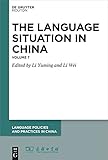The Language Situation in China. Volume 7, 2016 / ed. by Li Yuming, Li Wei.
Material type: TextSeries: Language Policies and Practices in China [LPPC] ; 9Publisher: Berlin ; Boston : De Gruyter Mouton, [2022]Copyright date: ©2023Description: 1 online resource (VIII, 410 p.)Content type:
TextSeries: Language Policies and Practices in China [LPPC] ; 9Publisher: Berlin ; Boston : De Gruyter Mouton, [2022]Copyright date: ©2023Description: 1 online resource (VIII, 410 p.)Content type: - 9783110799729
- 9783110799781
- 9783110799750
- Bilingualism -- China
- Chinese language -- Variation
- English language -- Study and teaching -- China
- Language and culture -- China
- Language and education -- China
- Language planning -- China
- Language policy -- China
- China
- Chinesisch
- Sprachpolitik
- LANGUAGE ARTS & DISCIPLINES / Linguistics / General
- China
- Chinese Language
- Language Policy and Planning
- 306.44/951 23
- P119.32.C6 L37 2013
- P119.32.C6 L35 2016
- online - DeGruyter
- Issued also in print.
| Item type | Current library | Call number | URL | Status | Notes | Barcode | |
|---|---|---|---|---|---|---|---|
 eBook
eBook
|
Biblioteca "Angelicum" Pont. Univ. S.Tommaso d'Aquino Nuvola online | online - DeGruyter (Browse shelf(Opens below)) | Online access | Not for loan (Accesso limitato) | Accesso per gli utenti autorizzati / Access for authorized users | (dgr)9783110799750 |
Frontmatter -- Contents -- Editorial Teams of the English Edition -- Part I: Special report -- 1 Improving national language ability and serving the comprehensive construction of a moderately prosperous society -- 2 Promoting the lawful supervision and evaluation of spoken and written language work -- 3 Scientific research work of the State Language Commission in the “12th Five-Year” period -- Part II: Special focuses -- 4 Origin and significance of the Project for the Protection of Language Resources of China -- 5 Orientation, objectives, and tasks of the Project for the Protection of Language Resources of China -- 6 Strategies and methods for implementation of the Project for the Protection of Language Resources of China -- Part III: Language work -- 7 Work on spoken and written ethnic minority languages -- Part IV: Special fields -- 8 Survey of the state of rural language use in Hubei Province -- 9 The situation of “dialect culture entering the classroom” in three coastal locations -- 10 Survey of language use in regions inhabited by the Lahu and Mongolian ethnic groups -- 11 Survey of language use among Hong Kong, Macanese and Taiwanese college students at inland institutions of higher education -- 12 Survey of foreign language ability in the field of civil aviation -- 13 Issues with standards for language use in military documents -- 14 State of development of the Confucius Institutes (2015) -- 15 The state of development of Chinese language and culture education (2015) -- 16 Survey of the state of Chinese language education at institutions of higher education in four Central Asian countries -- 17 Publication of the third edition of Ciyuan (辞源) -- 18 An examination of literature and history textbooks in Manchukuo -- Part V: Hot topics -- 19 “Two-Child Policy” triggers a frenzied linguistic carnival -- 20 A “hot reaction” to the abbreviation of school names -- 21 Trending word lists for various sectors and industries -- Part VI: Words and passages -- 22 Writing the annals of the characters and words of the year, 2015 -- 23 Hot topics in society in the neologisms of 2015 -- 24 China and the world in the popular phrases of 2015 -- 25 The grassroots variety of online slang in 2015 -- 26 Comparative analysis of the use of alphabetic words in the media in 2015 and 2006 -- 27 The Internet+ in language life -- Part VII: Hong Kong, Macau and Taiwan -- 28 The Chinese language arts curriculum in Hong Kong pre-primary education -- 29 The language associations of Macau -- 30 The state of language life in Taiwan (2015) -- Appendices -- 31 Chronicle of events in language life (2015) -- 32 Language-related content in the official documents of the Central Committee of the Chinese Communist Party, State Council and relevant ministries and commissions -- 33 Work on the standard spoken and written Chinese language -- Index
restricted access online access with authorization star
http://purl.org/coar/access_right/c_16ec
China, with the world's largest population, numerous ethnic groups and vast geographical space, is also rich in languages. Since 2006, China's State Language Commission has been publishing annual reports on what is called "language life" in China. These reports cover language policy and planning invitatives at the national, provincial and local levels, new trends in language use in a variety of social domains, and major events concerning languages in mainland China, Hong Kong, Macau and Taiwan. Now for the first time, these reports are available in English for anyone interested in Chinese languge and linguistics, China's language, education and social policies, as well as everyday language use among the ordinary people in China. The invaluable data contained in these reports provide an essential reference to researchers, professionals, policy makers, and China watchers.
Issued also in print.
Mode of access: Internet via World Wide Web.
In English.
Description based on online resource; title from PDF title page (publisher's Web site, viewed 25. Jun 2024)


